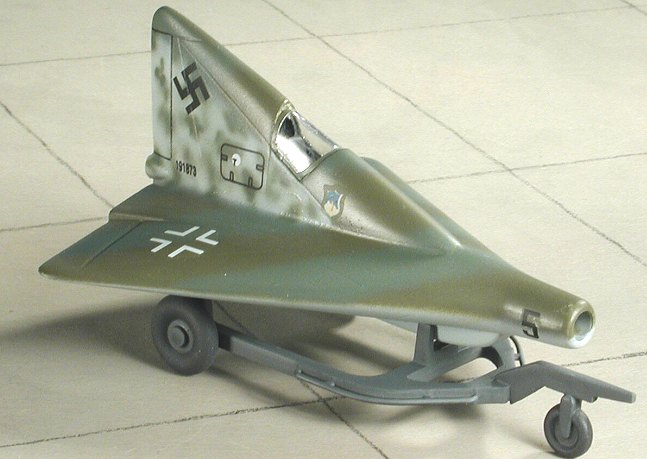
|
KIT # |
PM-224 |
|
PRICE: |
$5.98 SRP |
|
DECALS: |
Generic Luftwaffe |
|
REVIEWER: |
|
|
NOTES: |
Luft '46 |

|
ALTERNATE HISTORY |
It was March of 1947, Oblt. Johannes Farber, a 78 kill ace with 3./JG 1, was called into the office of Maj. Wolfgang Schreck, the commanding officer. "Farber, I have a job for you that I think you are suitably qualified for. The brainy boys have come up with a new aircraft and I want you to establish a test unit to try this little gem out in combat. Now I know you had hoped to stay here in Germany where the living is easy and one only has to go up now and again to stave off snooping British and American recce planes, but this is an important mission. What's more, you get to enjoy basking in the desert sun while doing it!"
Farber thought about just where "..the desert sun.." might be when his attention was drawn back to the C.O. "I want you to choose five other pilots and a suitable number of trained ground crew for this mission," Shreck said. "You will be flying a new type of aircraft, but you are used to rocket planes thanks to your successes with the Ju-263, so it won't be all that different. You and your men have a week's leave prior to reporting to your new assignment. Here are all the permission papers and other materials on the new plane. This is all very secret so do not let anything happen to these." A large briefcase was thrust into his hands. "Good luck and much success to you."
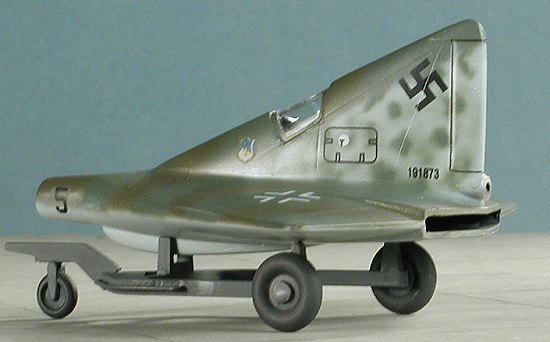 Returning to his
quarters, Farber locked the door and opened the briefcase. Well, so they
want to send me to Persia for this. That should put me pretty close to the
front lines with the British and the Russians. Now let's see what this
secret plane is. In the folder was a full description of a new aircraft
designed by Alexander Lippisch. This radical little fighter was designed as
a point defense interceptor and operated by rocket to get to speed and then
by ramjet to continue on with its mission. It was to be powered by the
standard Walther bi-fuel rocket to accelerate it to around 750 kph when the
ramjet would take over. The ramjet was to be powered by a coal slurry! Most
unusual. Why they didn't use regular fuel was beyond Johannes' ken as there
was plenty of oil in Persia, but he was only the pilot so I'm sure they had
their reasons.
Returning to his
quarters, Farber locked the door and opened the briefcase. Well, so they
want to send me to Persia for this. That should put me pretty close to the
front lines with the British and the Russians. Now let's see what this
secret plane is. In the folder was a full description of a new aircraft
designed by Alexander Lippisch. This radical little fighter was designed as
a point defense interceptor and operated by rocket to get to speed and then
by ramjet to continue on with its mission. It was to be powered by the
standard Walther bi-fuel rocket to accelerate it to around 750 kph when the
ramjet would take over. The ramjet was to be powered by a coal slurry! Most
unusual. Why they didn't use regular fuel was beyond Johannes' ken as there
was plenty of oil in Persia, but he was only the pilot so I'm sure they had
their reasons.
Reading further, he saw that initial tests on the plane showed it to be an excellent performer, but required a highly skilled pilot. That pretty well helped him make up his mind on the other pilots that will be required. He jotted down some names and headed over to the maintenance shed to pick ground crew; all the time thinking about warm weather and the chance for some action.
Three weeks later, now promoted to Hauptman, Johannes established what was now Ekdo Farber and their new P.13a fighters, all standing in the desert sun in what was obviously the wrong camouflage of green and brown. He'd have a chat with the maintenance officer about having something more suitable applied. Meanwhile, all the pilots had an initial test flight in each of the planes and found them to be a real handful. The newer Walther design for the booster rocket got them up to speed in a very short amount of time and even has sufficient fuel left over so they could be restarted if needed for landing. Not having wheels made for a rather rough landing, but with a reinforcement plate on the bottom and the 'runway' smoothed off, it wasn't as horrible as it sounds. Apparently later versions will have proper wheels and he looks forward to that. They will also be larger, but right now, his job is to develop tactics and prove the weapons system is viable.
Here, close to Tehran, there is opportunity to go against Allied aircraft for the British and what is left of the Russians are now flying B-29s that the Americans have provided them. With Germany in full control over eastern Russia, the Near East and North Africa, supplies are not a problem as they were in the dark days of early 1944. Were it not for the stupidity of Montgomery and his invasion attempt near Calais, where the Wehrmact was massed, the Allies may have gotten a toe-hold in Northern Europe. That calamity caused a real shake-up in Allied planning and allowed the Germans to retake all the territory they'd lost in the Med by mid 1945.
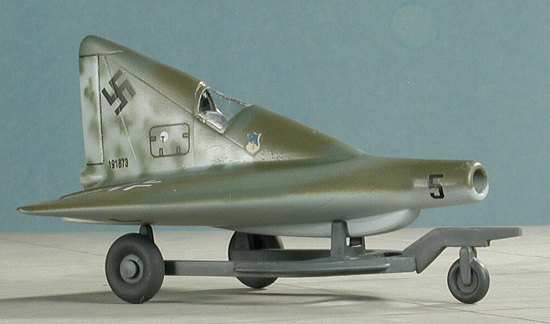 An uprising in Russia
over Stalin's cruelty saw the rather gruesome death of the dictator and the
country sued for peace. This split the nation with Russian Federation in
the east and the Soviet Protectorate operating east of the Urals under the
control of some hard-core communists. The Japanese had stalemated the
US in New Guinea and a decisive victory in Midway during the early years of
the war had put the US on a defensive stature. No one was making any real
advances except in China where the war swung back and forth.
An uprising in Russia
over Stalin's cruelty saw the rather gruesome death of the dictator and the
country sued for peace. This split the nation with Russian Federation in
the east and the Soviet Protectorate operating east of the Urals under the
control of some hard-core communists. The Japanese had stalemated the
US in New Guinea and a decisive victory in Midway during the early years of
the war had put the US on a defensive stature. No one was making any real
advances except in China where the war swung back and forth.
Making sure the planes were all fully fueled, Hauptman Farber walked over to the radar shack to see if anything was coming. Reports of a small raid had been sent by spies in Kabul, where the British had a B-29 base, but the target was, as yet, unknown. One thing for sure, they'd have to fly over Farber's base in order to reach Tehran.
Dozing in the sun, the alert sirens suddenly went off. Farber and three other pilots hurried to don their protective gear and climb the ladder into their little fighters. They then warmed up systems using the ground power cart and once all checks had been made, contacted control for instructions. A small group of 8 aircraft was headed for the supply dumps in Tehran and flying at rather high altitudes. All the fighters were aimed down the wide landing and take off area. The power carts were removed and the planes were now on internal batteries.
Word was given from the control room that the enemy was nearly overhead so one by one, they started their rocket motors and headed down the still-bumpy ground. As soon as Johannes pulled back on the stick, the ground trolley separated and went off into the desert. The G forces were tremendous as he climbed out at a 45 degree angle. 5,000 meters was reached in just under a minute while 12,000 meters, the height of the bomber formation, was attained just a few minutes later. During the climb, the aircraft reached ram-jet speed and after a burst of ignition, the ram-jet took over and the rocket shut down.
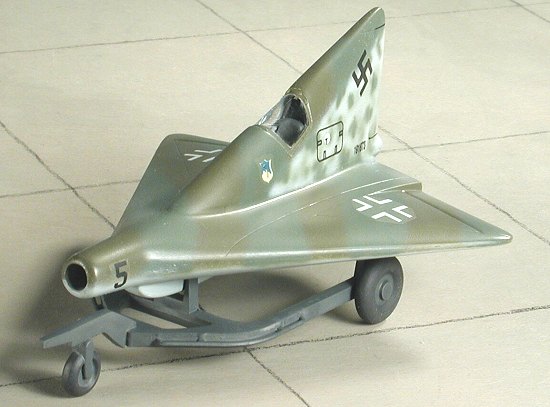 Because of the short
flight duration of the aircraft, rarely did a unit go into battle as a
group. It was a case of get up there and shoot down as many planes as
possible in as short a time as possible. Standard procedure for 263 pilots.
The twitchy P.13 required a master's touch on the controls or it could go
into a wicked spin. Throttling back to just above minimum ram speed, Farber
looked for the enemy. Just ahead he spotted a small formation of bombers.
Each was painted in a two tone desert scheme.
Because of the short
flight duration of the aircraft, rarely did a unit go into battle as a
group. It was a case of get up there and shoot down as many planes as
possible in as short a time as possible. Standard procedure for 263 pilots.
The twitchy P.13 required a master's touch on the controls or it could go
into a wicked spin. Throttling back to just above minimum ram speed, Farber
looked for the enemy. Just ahead he spotted a small formation of bombers.
Each was painted in a two tone desert scheme.
As he closed, they spotted him and defensive fire came at him from all eight bombers. He flicked over the safety on his 30mm cannon and a few short bursts were sent into the nearest plane. Hitting it in the wing root, the wing slowly crumpled and the plane fell out of formation. He looked down to see parachutes drifting from the doomed bomber.
Zooming up for another try, he saw another plane fall from the formation, victim of one of his fellow pilots. He lined up on one of the planes and started in a pursuit curve. When he got into range, he let off a few more squirts of his 30mm cannon, small explosions showing where the fuselage was hit in the rear. Return fire was murderous and he felt several hits shake his little fighter. One must have hit something important for as he was closing, the aircraft started sliding out of control.
Fighting with the controls, Farber headed down below the area of battle. He shut down the fuel supply to the ramjet and applied all his skills to regaining control. The altimeter started its wild spin as he lost more and more altitude. Finally, at 2,000 meters, he knew he couldn't save it and fired his ejection seat to clear the still gyrating aircraft. Falling into silence, he looked around a bit and saw his little fighter slam into the desert below. Above him the fight had finished with several successes amongst his comrades, but with most of the bombers still headed towards their targets in Tehran.
He hit the ground with a thump and after gathering up his chute, started the usual preparations for being rescued in the desert. A short time later an the Flettner rescue helo had picked him up and he was on the way back to base. During the trip, he thought of what to say in his report back to Germany on the viability of these little planes and came to the conclusion that there was a lot of work to be done before these were ready for average Luftwaffe pilots!
|
BACKGROUND |
|
CONSTRUCTION |
Did the same for the fin except for the putty bit.
Again, I snipped the alignment pins and cleaned things up a bit. I'm going
to have to hollow out the rocket nozzle. It is slightly short shot on one
side and solid on the other (or maybe that is just thick flash). I also got
my usual putty and applied it to the nose wheel bit where there are some
ejector pin marks and to the top of the trolley frame where there are some
sink marks. While that was drying I attached the seat back
After the usual puttying and sanding I mated the fin to the lower surface.
The result is a seam larger than Dolly Parton's cleavage. It took several
applications of filler to get a relatively smooth transition. Meanwhile,
I'd tried to sand/carve a proper intake without having much luck. What I
ended up doing was taking a piece of scrap brass tubing and shoving it in
the front. I then applied some superglue to fill the gaps around it and
when that was dry, put on some filler to take care of any additional holes.
In the back where the short-shot rocket nozzle was located, I filled that
will superglue and when it was dry, it was drilled out. Back
at the handling cart, the nose section was glued in place. Then when all
was dry, the assembly was painted RLM 66 dark grey. Back at the aircraft, I
removed the rather brittle canopy from its sprues and noted that it had a
few chunks out of the plastic. Not only that, but it is smaller than the
opening into which it needs to be place. Now there are several options: one
is to go ahead and use the kit canopy, another is to make a new one from
vac plastic that is the right size and a third option is to use a large
piece of clear tape to cover the opening. Downside to this last option is
that anything floating around in the interior will eventually get stuck to
the inside of the tape, but it is a cheap option. I stayed with the too
small canopy, glued it in place and then filled in any of the little nicks
with superglue. I then masked it in preparation for painting. CAMOUFLAGE & MARKINGS Being a Luft '46 aircraft, I can do anything I want to with it in terms
of camouflage. Keeping pretty standard, I started off by
A coat of Future was applied and then it was time for decals. I used as
many of the kit decals as I could and that basically meant the T-Stoff
access doors, upper and lower insignia and the serial number. The rest were
just too badly out of register to use. I scarfed the swastikas from an
XtraDecal sheet and the nose numbers from an old Supermodel sheet for the
CR.32. The unit badge came from what I think is a Heller Me-163 sheet, but
it is really old and yellowed. Once dry, it was resprayed with a semi-matte
clear coat. Unfortunately, I got the clear coat contaminated (gee, you are
supposed to CLEAN your airbrush between paints?). I had a darker area of
which I sanded off some, but to do the rest would have trashed the decals
so I just let things be (see image to left). 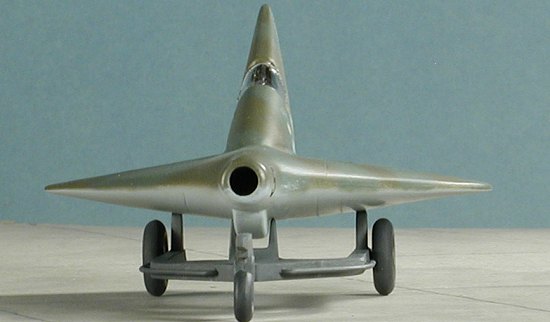 Gee, with all these parts (11 total) it is hard to decide
where to begin! Actually, I started by removing the main body and fin parts
from the sprue, cleaning up the attachment points and test fitting them.
Step one is to cut off the alignment pins as they are not true (at least on
my kit). Second is to sand or scrape the various intakes/exhausts to get
rid of the seams and light flash. Third is to find something to plug the
fuselage with or there will be a see-through effect. Looking about the
workbench for something that won't violate the OOB nature of this review, I
espied as lump of putty in the corner. This a special putty by JHO that is
supposed to stay a bit tacky so that it will hold parts for painting and
such. Well after a while it gets way too tacky and is a real mess to use
with little bits sticking to parts and being hard to remove. I'd not tossed
it because I thought I might find a use for it. Well I have. I made a
little ball of it, stuck it just behind the intake and mushed the top of
the fuselage. There isn't so much as it oozes out the cracks and its
tenacity for sticking should keep it in place for decades! I then glued the
seam.
Gee, with all these parts (11 total) it is hard to decide
where to begin! Actually, I started by removing the main body and fin parts
from the sprue, cleaning up the attachment points and test fitting them.
Step one is to cut off the alignment pins as they are not true (at least on
my kit). Second is to sand or scrape the various intakes/exhausts to get
rid of the seams and light flash. Third is to find something to plug the
fuselage with or there will be a see-through effect. Looking about the
workbench for something that won't violate the OOB nature of this review, I
espied as lump of putty in the corner. This a special putty by JHO that is
supposed to stay a bit tacky so that it will hold parts for painting and
such. Well after a while it gets way too tacky and is a real mess to use
with little bits sticking to parts and being hard to remove. I'd not tossed
it because I thought I might find a use for it. Well I have. I made a
little ball of it, stuck it just behind the intake and mushed the top of
the fuselage. There isn't so much as it oozes out the cracks and its
tenacity for sticking should keep it in place for decades! I then glued the
seam.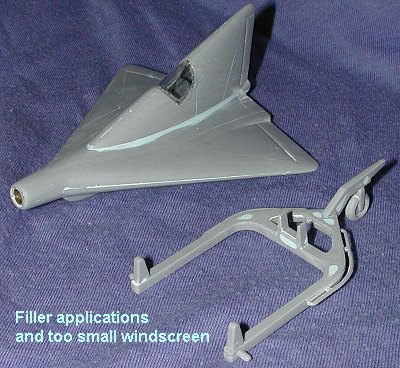 and stuck the
control stick (and it is just a straight piece of sprue) into the hole.
Careful that it doesn't fall through! The interior (such as it is)
was then painted RLM 66 as was the interior of the fin.
and stuck the
control stick (and it is just a straight piece of sprue) into the hole.
Careful that it doesn't fall through! The interior (such as it is)
was then painted RLM 66 as was the interior of the fin.
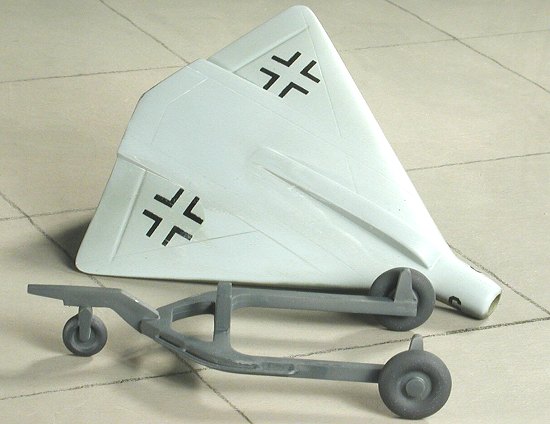 spraying the
underside and fin with RLM 76 using Testors ModelMaster enamels. Then the
entire upper side was painted RLM 81 (basically a brown) using the Colors of Eagles acrylic.
Since I wasn't going to do any detail stuff with the acrylic, that worked
out well. Then RLM 82 (dark green) was sprayed on it in a banded pattern.
The side of the fin was then painted RLM 76 and mottled with RLM 82.
spraying the
underside and fin with RLM 76 using Testors ModelMaster enamels. Then the
entire upper side was painted RLM 81 (basically a brown) using the Colors of Eagles acrylic.
Since I wasn't going to do any detail stuff with the acrylic, that worked
out well. Then RLM 82 (dark green) was sprayed on it in a banded pattern.
The side of the fin was then painted RLM 76 and mottled with RLM 82.
|
FINAL CONSTRUCTION |
Really, the last thing to do was to glue the wheels on the handling trolley and remove the masking from the cockpit. Dirty these things wouldn't have gotten as the fuels they used would have been pretty clean burning and all the exhaust exited in the back of the plane. As you know, I usually use RLM 66 for tires, but since I'd painted the trolley that color, I had to find something else so used Floquil's Weathered Black which made a reasonable contrast. I'd considered drilling out the gun ports, but I'd have also had to make shell ejector ports so I passed on that addition.
|
CONCLUSIONS |
As you can see, few parts does not necessarily mean an quick build. It isn't anything catastrophic but one has to expect glitches from the smaller companies. You'd have thought that PM would have been around long enough so they wouldn't do the 'too small canopy' bit, but apparently engineering isn't #1 for these folks. Despite that and the rather low detail level, the end result is pretty neat and will look cool on my Luftwaffe '46 shelf (below). Give it a try as this one really is a model that can be constructed and painted in a week!

October 2003
#1287 in a series
Copyright ModelingMadness.com. All rights reserved. No reproduction in part or in whole without express permission from the editor.
If you would like your product reviewed fairly and quickly, please contact the editor or see other details in the Note to Contributors.